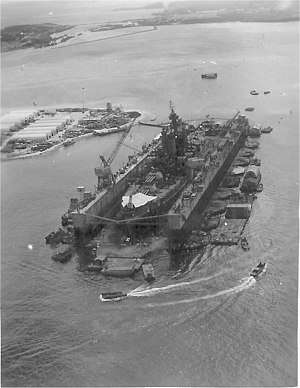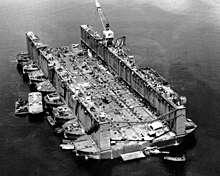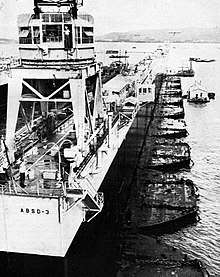USS ABSD-3
ABSD-3 is an advanced base sectional dock, constructed of nine advance base dock (ABD) sections for the US Navy as an auxiliary floating drydock for World War II. ABSD-3 was delivered to the US Navy in April 1944, and was commissioned on 27 October 1944. Advance Base Sectional Dock-3 (Auxiliary Floating Dock Big-3) was constructed in sections during 1942 and 1943.
 | |
| History | |
|---|---|
| Name: | ABSD-3 (AFDB-3) |
| Builder: |
|
| Laid down: | 1943-1943 |
| Launched: | 1943 |
| Acquired: | April 1944 |
| Commissioned: | 27 October 1944 |
| Out of service: | 1948 |
| Reclassified: | AFDB-3 (Large Auxiliary Floating Dry Dock) |
| Honours and awards: |
|
| General characteristics | |
| Type: | Advance Base Sectional Drydock |
| Displacement: | 30,800 long tons (31,294 t) |
| Length: | 844 ft 3 in (257.33 m) |
| Beam: | 246 ft 5 in (75.11 m) |
| Draft: | 8 ft 8 in (2.64 m) |
| Propulsion: | None |
| Complement: | 22 officers and 471 enlisted men |
| Armament: |
|


Each section was 3,850 tons and 93 feet long. Each section had a 165 feet beam, 75 feet molded depth and 10,000 tons lifting capacity. There were four ballast compartments in each section. With all nine sections joined, she was 844 feet long and 28 feet tall (keel to welldeck), with an inside clear width of 133 feet 7 inches. ABSD-2 had a traveling 15-ton capacity crane with an 85-foot radius and two or more support barges. The two side walls were folded down under tow to reduce wind resistance and lower the center of gravity. ABSD-3 had six capstans for pulling, each rated at 24,000 lbf (110,000 N) at 30 ft/min (0.15 m/s). Four of the capstans were reversible.[1][3]
Construction
The nine sections that made up dock ABSD-3 were built at four different shipyards, to speed up construction:
- Section A - Pollock-Stockton Shipbuilding Company in Stockton, California
- Sections B & F - Everett-Pacific Shipbuilding & Dry Dock Company in Everett, Washington
- Sections C & E - Chicago Bridge in Morgan City, Louisiana
- Sections D, G, H & I - Pittsburgh-Des Moines Steel Co., Pittsburgh, Pennsylvania
World War II
Commissioned on 27 October 1944, the USS ABSD-3 was assigned to the Asiatic-Pacific Theater. It was towed in sections to the Naval Base Guam at Apra Harbor in Guam, Marianas Islands. After assembling she was placed in service to repair ship at Guam with ABSD-6.
On an island in the harbor at Guam the Navy built a base to support the crew of ABSD-3 and ABSD-6. At the base were supplies, movie theater, mess hall, officers' clubs, movie theater, and enlisted club. The base was built mostly with quonset huts.
The largest repairs at Guam were that of the USS Pennsylvania near the end of World War II; the ship was hit by a kamikaze attack off Okinawa on 12 August 1945. Due to the Pennsylvania's 28.9 ft (8.8 m) draft with a full load, the battleship had to unload much of her ammunition and fuel oil before entering AFDB-3. The USS Idaho (BB-42) was also repaired in ABSD-3 after a kamikaze attack on the same day.
Able to lift 90,000 tons, ABSD-3 could raise large ships such as aircraft carriers, battleships, cruisers, and large auxiliary ships, out of the water for repair below the waterline. She was also used to repair multiple smaller ships at the same time. Ships in continuous use during war need repair both from wear and from war damage from naval mine and torpedoes. Rudders and propellers are best serviced on dry docks. Without ABSD-2 and her sister ships, at remote locations months could be lost in a ships returning to a home port for repair. ABSD-3 had power stations, ballast pumps, repair shops, and machine shops, and could be self-sustaining. ABSD-2 had two rail track moveable cranes able to lift tons of material and parts, for removing damaged parts and installing new parts.
The first ship repaired at Guam was on 5 March 1945 and the last ship on 5 March 1946, after one year of operation.[5]
- Ships ABSD-3 repaired during World War 2:[6]
- USS Napa (APA-157)
- LST 802
- LST 822
- PC 42
- USS Minneapolis (CA-36)
- LCI 544
- LCI 610 Landing Craft Infantry
- AK 142 - Cargo Ship
- LST 688
- LST 442
- YD USS McInteze
- USS Alnitah (AK-127)
- LST 827
- HM LST-421
- USS LST-486
- LCT 840
- LCT 830 Landing craft tank
- LCT 868
- LCT 846
- AOD 186
- USS LST-546
- LST 646
- LCI 890
- LCI 910
- USS Idaho (BB-42)
- USS South Dakota (BB-57)
- USS Arkansas (BB-33)
- YNT AN-48 USS Lancewood Net Layer Tug
- YNT AN-47 USS Canotia
- USS LST-1000
- USS LST-767
- LST 609
- USS Pittsburgh (CA-72)
- YDGT 7
- SC-760 Submarine chaser
- SC-1317 Submarine chaser
- YMS 403 Minesweeper
- YMS 361 Motor Minesweeper
- YMS 163
- AGS 14 a surveying ship
- APC 102 small coastal transport
- APC 25
- APC 45
- USS Earle B. Hall (DE-597)
- USS Tillman (DD-641)
- YMS 845
- AM 50
- USS Rescue
- AK USS Edward G. Acheson, cargo ship
- USS Munsee (ATF-107)
- LCI 562
- SC 658 Submarine chaser
- AV 4
- LST 789
- LSM 476
- USS St. George (AV-16)
- LST 800
- LSM 208 Landing Ship Medium
- LCT 971
- LCT 358
- LCT 1182
- LCT 911
- LCT 912
- LCT 945
- LCT 817
- LCI 321
- SC 677
- AK SS E B Cargo Ship
- AK SS Abigail Adams
- FD 188 US Army
- LCT 1185
- YMS 163
- GS 11
- LSM 439
- SC 654
- USS Lamar (PCE-899)
- USS Kern (AOG-2)
- LCI 1290
- PC 787 patrol craft
- AK SS Ida Tarbell
- Ak SS SS Carlos J. Finlay
- LCT 803
- MS 323
- AN 68
- YMS 275
- YTB 299
- YD
- AU 22
- LCT 1010
- LCT 905
- USS Pennsylvania (BB-38)
- APA SS B. Dixon
- GAGL 308 Papaw
- USS Wantuck (APD-125)
- LCI 910
- LCI 784
- BCL 3068 (Concrete#42 Uranium)
- YPK 3 Salvage Pontoons
- USS Mona Island (ARG-9)
- YC 1132
- USS Locust (AN-22)
- YF 771 Freight Barge
- LST 621
- LST 831
- USS LST-931
- LCI 461
- LCI 355
- LST 986
- LCM 184
- LCM 37
- LCM 256
- LCI 689
- YF 768 Barge
- APL 15 APL-2 non-self-propelled barracks
- LCI 817
- LCI 1064
- LCM 140
- LCM 142
- FS-255 (U.S. Army ship)
- FS 229
Commanding officers
- Commander Asel Bayless Kerr, USN, from 27 October 1944 to 28 December 1944
- Lieutenant Commander Leo Kampman, USN, from December 1944 to 15 February 1945
- Commander Asel Bayless Kerr, USN, from 15 February 1945 to 17 March 1946
- Lieutenant commander Leo Kampman, USN, from 17 March 1945 to 1 April 1946
Post-war
After the war ABSD-3 was decommissioned from the US Navy on 1 April 1946. Some sections were laid up in the Atlantic Reserve Fleet in Green Cove Springs, Florida. Some sections were stored in the James River Reserve Fleet from 1979 to 1982.[7]
She was struck from the Naval Register on 1 August 1981.
On 1 April 1982 eight sections were sold to Bath Iron Works in Bath, Maine. In 1982 she was towed to Portland, Maine. Bath Iron Works used the dock to lift new Bath Iron Works' built Guided missile destroyers (DDG) to install sonar domes on the new ship's bow. The USS Samuel B. Roberts (FFG-58) was one of the ships serviced at the Bath Iron Works in May 1998. Bath Iron Works built a new land dry lock facility and no longer needed ABSD-3.[8]
In 1999 she was sold and then in 2000 moved to two pieces (four sections) with the heavy-lift ship MV Blue Marlin to a shipyard in Rijeka, Croatia.[9]
External links
- Youtube, BATTLESHIP USS IDAHO REPAIRED AT ESPIRITU SANTO in 1944 in USS Artisan (ABSD-1)1
- Youtube, August 15, 1944 mighty battleship Idaho at ABSD-1
- Youtube, Floating Dry Docks WWII
- ABSD-3 crew photo with battleship Pennsylvania (BB-38) in the dock.
- Photo of USS ABSD-3 engineering crew basketball team "Champs" in July 1945 at Guam
- Photo USS ABSD-3 engineering crew of Section D-E-F, at Guam in July 1945. George "Bing" Crosby - 2nd left - back row
- Color Photo of ABSD-3 with USS Idaho (BB-42) in drydock
- Photo ABSD-3 at work in Bath Iron Works, Portland yard
- Photo ABSD-3 aboard the Heavy Lift Vessel MV Blue Marlin at Portland, ME. Bath Iron Works, Portland yard
References
- The Pacific War Online Encyclopedia, Floating Dry Docks
- Angas, W. Mack, Capt. (CEC) USN (November 1945). "Sea Going Navy Yard Follows The Fleet". Popular Science: 121–124. Retrieved 2012-07-10.
- UN Navy Bureau of Ships Journal, Volume 1, page 7 May 1952
- ABSD-3 Repair records
- marad, Sections B
- Photos of USS Samuel B. Roberts on blocks in AFDB-3 in 1988
- "Floating Dry-Docks (AFDB, AFDM, AFDL, ARD, ARDM, YFD)". shipbuildinghistory.com. 30 April 2015. Retrieved 8 January 2019.